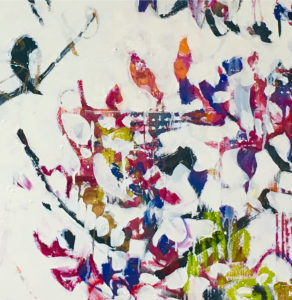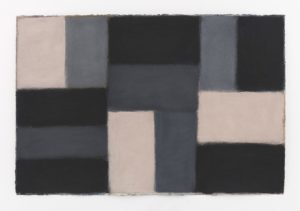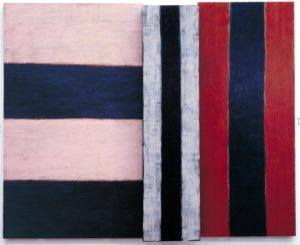Dear Artist,
This is a risky, time-consuming maneuver that involves pulling out a bunch of staples with the dream that I can do it again, only incrementally better. I used to beat myself up for this neurosis, thinking of it as a kind of character flaw manifested as perfectionism or a sisyphean make-work project to tamp down a galloping imposter syndrome. After years of this merry-go-round, I recently noticed that a painter I admire — one who seems, from a distance, to have it all together — repaints almost everything he makes. In fact, the other day, he posted a perfectly excellent example of his work and teased with the blurb, “thinking of repainting this, unless you tell me not to.” Was this senior artist really taunting his followers about whether to repaint his latest?
Years ago, while fine-tuning a series of somewhat messy but organized colourfield paintings, I cultivated a little system that I’d appreciate if we kept just between us. The One-Percent Gambit, or T.O.P.G involves stepping into your studio each day with the idea that you will improve the quality of your work by just one percent. One percent better idea, one percent more original, one percent deeper vibe, one percent stronger drawing, one percent more authentic, one percent tighter corner stretching, one percent more graphically sound, one percent more luminescent colour, one percent neater edges, one percent crazier vibration, one percent more poetic title, one percent greater totemic power, one percent more ineffable magic. I worked on The Gambit for many months, until one day, a collector whom I surmised to be of some consequence climbed the five flights of stairs to my West Village studio, stood at the foot of my bed and told me that, in her opinion, my work was of “museum quality.” I gave T.O.P.G the night off, and picked it up again the following morning.
These days, T.O.P.G. still rages in the form of staple removing and enough cross-examination to contort any person’s working eyeballs. Still, there’s something perversely satisfying about The Gambit. Day after day, hour after hour, the studio is a place where the pursuit of my own standard of excellence retreats coyly into the distance like a desert moonrise. I see it, and as I get closer, it ripples out there like a glowing and mysterious beacon. While I chase it, I get better, one percent at a time.
Sincerely,
Sara
PS: “Quality is never an accident; it is always the result of intelligent effort.” (John Ruskin)
Esoterica: As a person who well and truly removes staples for a living, I now, after almost three decades, have some authority with regards to T.O.P.G. It started in the early days, when my Dad told me that I should be able to look at my paintings and know if they’re creating the magic I need them to. “Does it sing?” he’d ask. “When it doesn’t quite make it,” he said, “it’s up to you to be the master and definer of the quality of your work. Quality,” he said, “is always in style.”
Have you considered a Premium Artist Listing? With each letter, an artist is featured at the bottom of this page. The Premium Artist Listings are a means of connecting artist subscribers through their work. Proceeds from each listing contribute to the production of The Painter’s Keys.
“I look at my paintings for a very long time before letting them out of my studio. I like to get on the treadmill and look around at all of my paintings while I exercise. I try to stare them down to make them reveal their weaknesses. If they reveal weaknesses, they get repainted.” (Sean Scully)
Featured Workshop
 Join Ellie Harold for “Intuitive Painting: Permission to Paint Expressively,” designed especially for mature women artists of all skill levels who wish to explore this medium for soulful exploration. The retreat provides attractive accommodations (your own room!) along with lightly structured activities for centering, relaxation and low stress art-making. You’ll have plenty of free time to muse, paint, write and reflect while enjoying the colors, textures and flavors of San Miguel. This Retreat has the potential to transform not only your art but your life! You’ll return home with a specific art “care plan” to assure support for further creating. Details at www.EllieHarold.com.
Join Ellie Harold for “Intuitive Painting: Permission to Paint Expressively,” designed especially for mature women artists of all skill levels who wish to explore this medium for soulful exploration. The retreat provides attractive accommodations (your own room!) along with lightly structured activities for centering, relaxation and low stress art-making. You’ll have plenty of free time to muse, paint, write and reflect while enjoying the colors, textures and flavors of San Miguel. This Retreat has the potential to transform not only your art but your life! You’ll return home with a specific art “care plan” to assure support for further creating. Details at www.EllieHarold.com.
Featured Artist
I am inspired by the drama of light as it moves along forms, the rhythms and nuances of shapes, and the colours that change from subtle to vivid at any give moment. My expressive compositions, in oils, acrylics or watercolours, are a contemplative and heartfelt response to my experiences, representing the “visual music” I feel. Each brush-stroke is like a colour note or chord playing out the scene offering a connection with the viewer through dynamic movements and vibrant colour.








15 Comments
I stare down my painting too!
I am a watercolor painter, and I am always taking my paintings out of their frames and tinkering with them – there’s always something. The result of this focus is that I tell people that my paintings are not finished until they are sold!
Self improvement is commendable and one should always strive to be their best. Painting is so easily transformed by as little as a brush stroke….I sometimes envy practitioners, but my medium of choice is not so easily altered….so experimentation is the gambit, along with knowledge of the medium and the individual “eye” that distinguishes style.
The examples you’ve chosen for this article are clearly in need of vast improvement….but that is my opinion….and the fact that they are considered worthy art proves that my opinion is worthless to anyone other than myself….1%.
Sara, I love the poetry of your description of T.O.P.G.!
And the simplicity. I feel my anxiety about making “ART” melt with the inspiration of just one percent improvement- brilliant!
Thank you!
Literally just pulled stables last week. Hopefully heading into my “third period” of art making. At the very least, I won’t need to look at that ugh-image ever again. There’s a definite feeling of release, enlightenment.
Thanks for this beautifully written description of what I struggle to convey – to myself and others! As a watercolorist I repaint from scratch over and over again. Sometimes I get it right the first time. Mostly I consider the first several versions as sorts of studies for the eventual success. Luckily I really enjoy the pursuit of T.O.P.G.!
Cool! Love the idea and am going to implement it!
Love this idea. One percent. I think I might be able to handle that. Every now and then I take a painting that I previously thought was finished and really go at it and it results inns much better painting but haven’t considered just systematically striving for improvement every single day. It’s easy to fall into a rut.
Thanks for these words.
I can’t imagine not hoping to achieve improvement in any time spent in the studio. I’m getting better at painting the sides of the wide edge canvasses now, that’s a one percent thing. Complete satisfaction is a rare conclusion serious artists achieve. I’m still under the influence of artistic surprise so not too disciplined in small studies and precious time spent on guaranteeing success. I know the work has to be done, the practice, the looking and looking, the looking and understanding of the why’s, but I also know there will be surprise that no preplanning can achieve. It’s very like performing. We know every second needed to practice and rehearse is a must, but that magic of being GOOD when the artistic director lifts his wand is a beautiful unknown. I so miss being able to perform, but so thankful very the similar senses that hit me with my painting. Thank you for making us think on this beautiful sunny April day, Sara!
This is a good post. Reading it will probably result in an improvement of my abilities (presuming I have any).
I have to put my work away after I “finish” it. Sometimes I hate it, sometimes I love it, but unless I give it a rest, I can’t tell if it’s good or not. I paint in oil, so if it is a fail, I just keep painting. I also work on paper. I have the option of washing watercolor off, gesso-ing over and making something new, or shredding, cooking and blendering to make new paper. Some of my work is very thick.
OMG
I thought I was one of the few afflicted with this disease. Strangely it has worked wonders in bring the work to the next level, though I have wrecked a few as well. Thank you for sharing Yes, you and I are unique, but so are hundreds of others going through this wonderful process.
Sara when you refer to “pulling staples” I assume you mean removing the canvas from the stretcher bars in order to stretch a fresh canvas, is that correct?
I’m a great believer in beginning again, see previous letters of your Dad re: dogs….jinxed, etc…..(okay I won’t get into the canine connotation, not fair to our faithful four legged friends). The upshot of which is that when a painting is going south it’s better to start another painting!
Personally, I prefer to have five or six paintings going all the time, so when I get struck I don’t belabor the point and overwork the piece but simply put it aside and pick up another with fresh eyes. Some lie in purgatory for weeks, months or even years until the right moment of resolution. No treadmill required. Just wish I had a bigger studio, doesn’t everybody?
The other thing I love is putting on 5-6 coats of gesso so when the oil painting looks meh you can sand it off and there’s plenty of gesso underneath. The encrustations don’t do it for me anymore.
http://www.lizreday.com
Wabi-Sabi.
Save your staples.
I like this 1% focus on improving quality as there is always some aspect to do this in and seems attainable.
When I look at my older paintings I see the echoes of steps taken that offer clues to steps I could still take. Like exuberant to calm by 1%. Successful or not, there will always be a canvas to return to and try another 1% Gambit.
I looked up the definition of Gambit and noted that it requires action, and entails a degree of risk, so I look forward to the adventurous tactics of TOPG! Thank you for sharing this secret key!